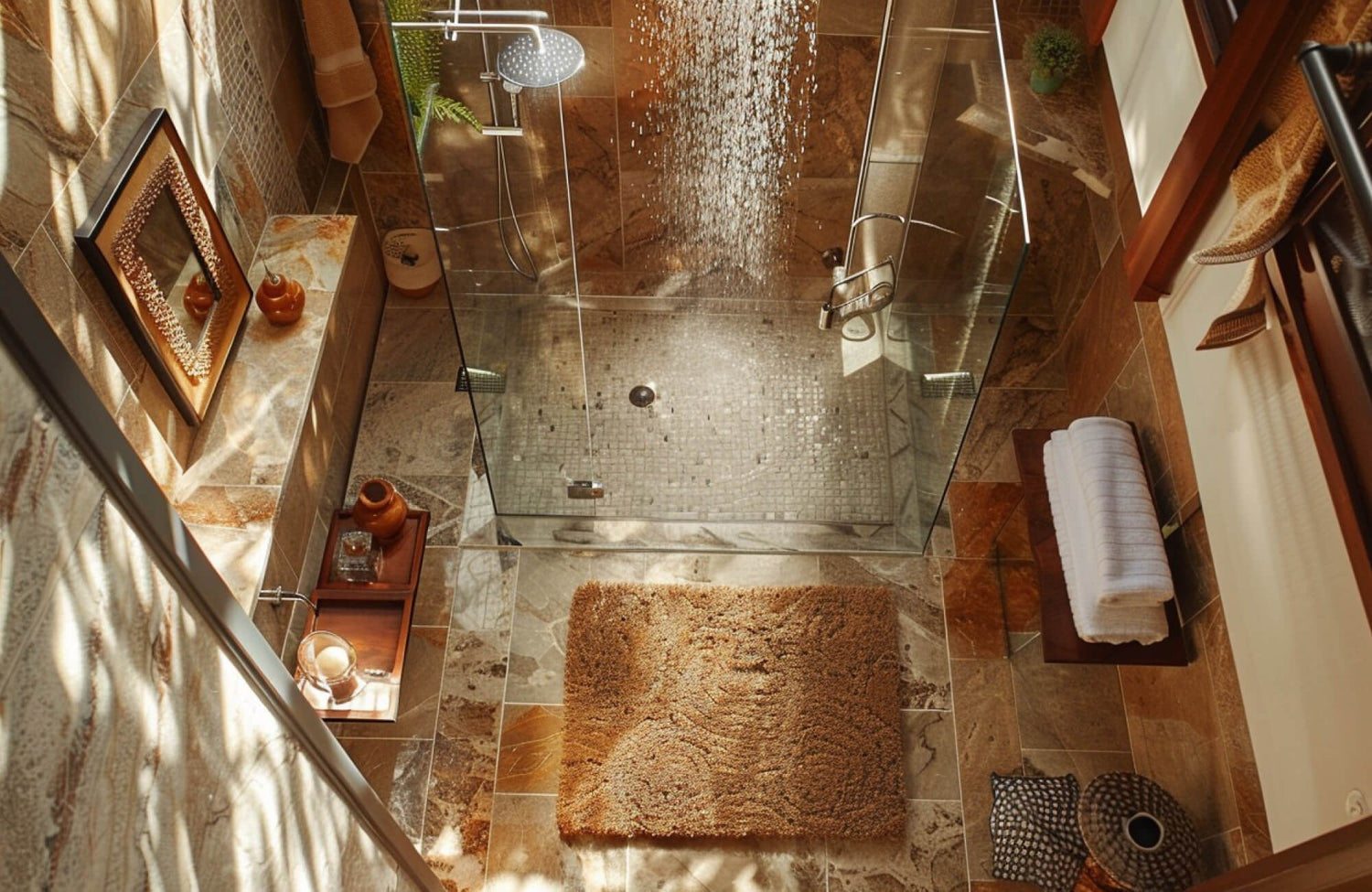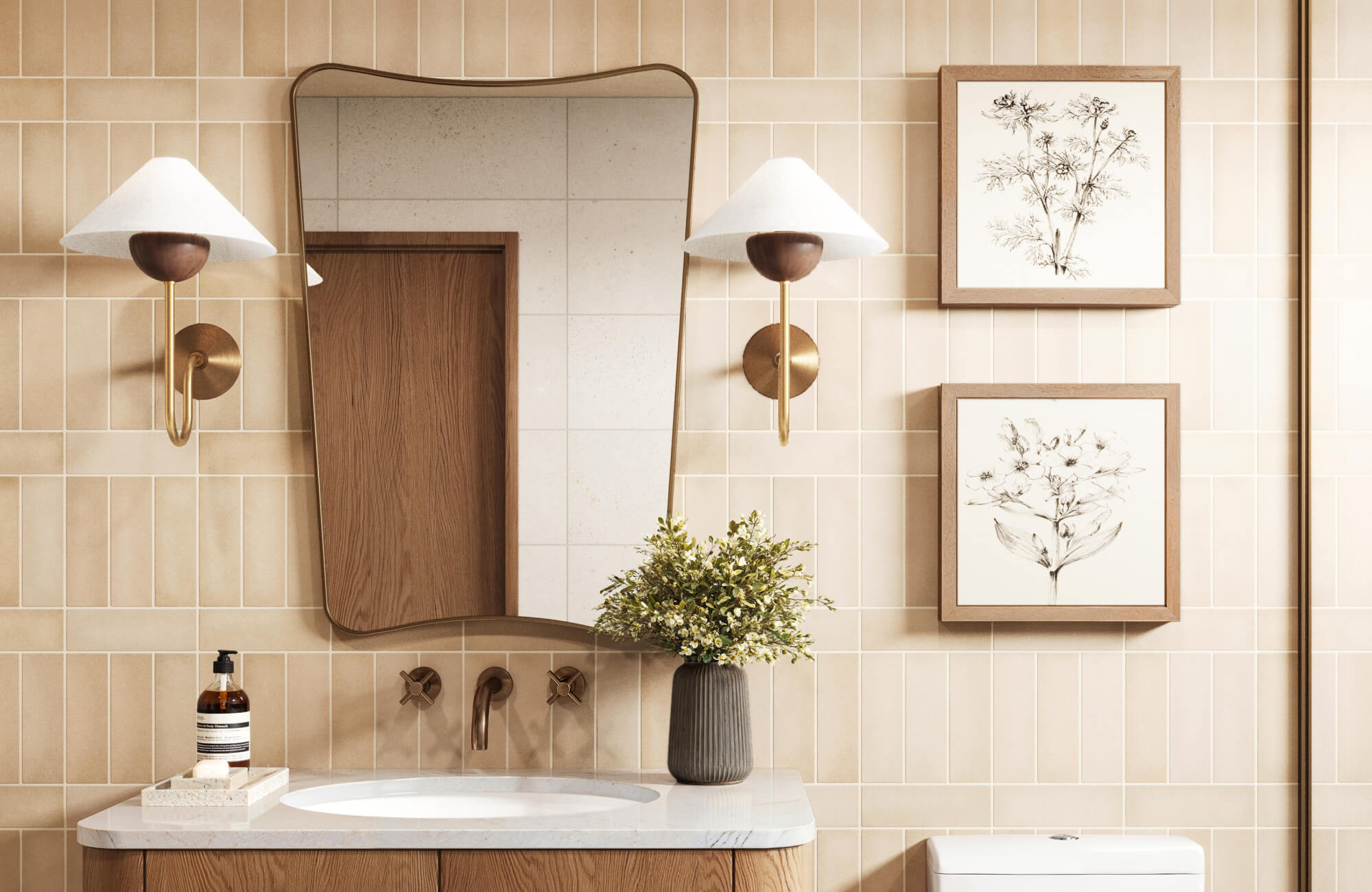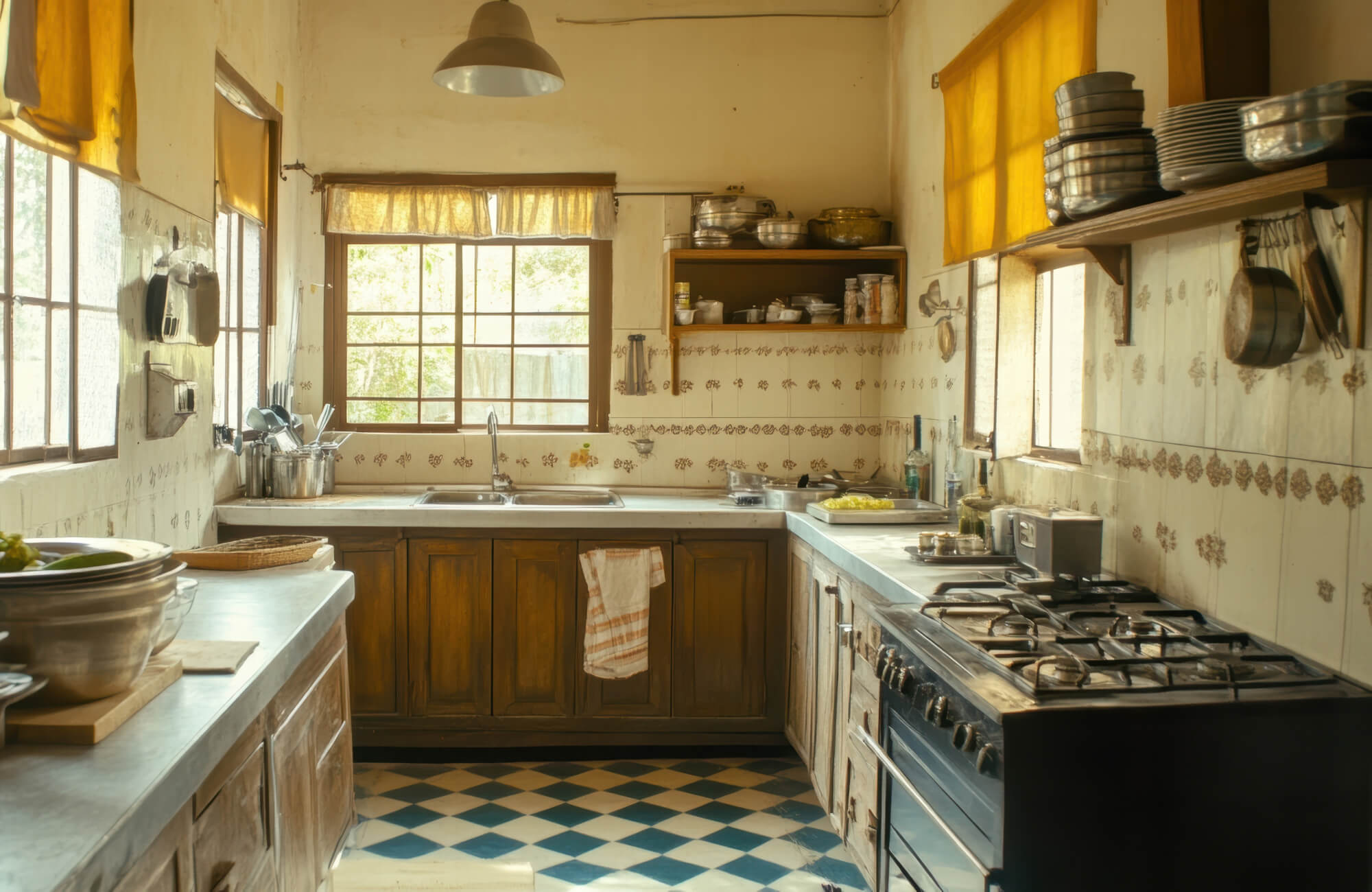If you’ve ever struggled with mold in your shower, you know how frustrating it can be to keep it clean. The good news is that choosing the right bathroom tiles can make a big difference in preventing mold and keeping your bathroom fresh. Since mold thrives in damp, humid spaces, picking moisture-resistant materials and the right grout can help you cut down on buildup and maintenance. In this guide, you’ll learn about the best tile options to keep your shower looking great and mold-free.

Why Mold Develops in Showers and How Tile Choice Matters
With all the heat and moisture in a shower, it’s no surprise that mold can become a problem. When water lingers on tiles and seeps into the grout, it creates the perfect environment for mold and mildew to grow. That’s why your choice of bathroom tile matters, it can either help prevent moisture buildup or make the problem worse. The best tiles for mold prevention are water-resistant, non-porous, and easy to clean, making it much easier to keep your shower fresh and low-maintenance.
Shower Moisture Levels
Showers generate constant moisture, with humidity levels often reaching their peak during and after use. Steam condenses on walls, floors, and grout lines, keeping surfaces damp for extended periods. Without proper ventilation or quick drying, this trapped moisture can seep into porous materials, creating an environment where mold grows. Managing moisture levels is also key to maintaining a cleaner, drier shower space.
How Tile Porosity Affects Mold Growth
Tile porosity plays a big role in moisture absorption and mold growth. Non-porous tiles like porcelain repel water, making it difficult for mold to grow. On the other hand, porous tiles such as natural stone can absorb moisture if left unsealed, creating the perfect environment for mold. You can further minimize the risk of mold buildup by applying a protective sealant, which helps block water and keep natural stone dry, reducing the chance of moisture absorption.
The Role of Tile Finish in Mold Prevention
The surface finish of a bathroom tile plays a critical role in its ability to shed water and resist the accumulation of organic residues. Glossy or glazed finishes, characterized by their smooth, impervious surfaces, facilitate efficient water runoff and can simplify the removal of soap scum and other debris. However, because of their slick surface, they are best suited for wall applications, as they can become slippery when wet.
In contrast, matte or textured finishes, while aesthetically appealing, may retain moisture and provide a foothold for mold growth, requiring more diligent cleaning protocols. Choosing the right finish based on both functionality and safety can also help maintain a cleaner, more practical shower environment.

Best Tile Materials for Mold Resistance and Longevity
Choosing the right bathroom tile material is one of the most important steps in preventing mold growth in showers. Some tiles naturally resist moisture and mold due to their composition and the way they are manufactured. These materials can also provide a more durable and low-maintenance solution, helping to keep your shower cleaner and healthier over time.
Porcelain Tiles
Porcelain tiles are one of the best choices for mold-resistant and long-lasting shower surfaces due to their low porosity, durability, and ease of maintenance. Their ability to resist moisture and stains makes them ideal for humid environments, helping to keep your shower clean and hygienic with minimal effort.
For shower floors, mosaic tiles with a matte or textured finish are highly recommended as they provide extra grip, enhancing safety in wet conditions. Edward Martin’s Wyatt 2x2 Matte Porcelain Mosaic Tile in Espresso featured above, is a perfect example, offering a slip-resistant surface while preventing moisture absorption and mold growth. Its durable, non-porous design ensures long-lasting performance, while its neutral tones can also create a seamless and stylish foundation for any shower space.
Ceramic Tiles
If you’re looking for a stylish and budget-friendly bathroom tile, ceramic is a great choice. It’s affordable, easy to maintain, and available in a variety of designs. Although more porous than porcelain, high-quality ceramic tiles with a durable glaze still provide excellent water resistance when properly installed and sealed. Since they’re lighter and more prone to chipping, they’re best suited for walls, backsplashes, and accent areas rather than floors. That said, their non-porous surface resists heat, moisture, and scratches, making them a practical option for bathroom walls.
A great example is the Marsden 3x10 Matte Ceramic Tile in Fawn, which features a warm, neutral tone and a matte finish that enhances grip and reduces moisture retention. Paired with mold-resistant grout and proper sealing, ceramic tiles can also offer both durability and elegance with minimal upkeep.
Natural Stone Tiles
Natural stone tiles, such as marble, granite, and travertine, are known for their rich textures and unique color variations, bringing a timeless elegance to any space. However, because they are naturally porous, they can absorb moisture if not properly sealed. To keep them mold-resistant, a high-quality penetrating sealant is essential to create a protective barrier against water. Regular resealing, typically once a year, is also necessary to maintain their durability and prevent mold growth.
The Importance of Proper Grout and Sealant Selection
When it comes to mold prevention, choosing the right grout is just as important as selecting the right bathroom tile for your shower areas. High-quality grout not only seals gaps and minimizes water infiltration, but it can also help protect the shower enclosure from excess moisture. However, to ensure it remains effective over time, regular maintenance and durable materials are essential. With the right grout and proper care, you can keep your shower mold-resistant and long-lasting.
Grout Type
Epoxy grout, made from a blend of resin and hardener, creates a dense, waterproof barrier that resists moisture and stains. Its durability and mold-resistant properties make it an excellent choice for showers, where constant exposure to water can lead to mold growth.
On the other hand, cement-based grout is a more budget-friendly option but is naturally porous, making it more prone to moisture absorption. Over time, this can also lead to mold and mildew buildup, requiring more maintenance and frequent cleaning. While both types have their advantages, epoxy grout provides a longer-lasting, low-maintenance solution for keeping your shower cleaner and more resistant to mold.
Sealing Strategies for Long-Term Protection
To enhance the longevity of grout lines, applying a high-quality penetrating sealer is essential. These sealers, often formulated with siloxane or silane compounds, seep into porous surfaces to create a protective, water-repellent barrier. By preventing moisture absorption, they can also help reduce the risk of mold growth and deterioration over time.
However, sealants don’t last forever. Regular reapplication, as recommended by the manufacturer, is necessary to maintain their effectiveness. Keeping up with this routine also ensures that your shower remains well-protected against water damage, stains, and mold buildup for years to come.
Choosing Mold-Resistant Caulk for Joints and Edges
When sealing shower joints and edges, silicone caulk is the best choice due to its flexibility and strong water resistance. Unlike other sealants, it maintains its elasticity over time, allowing it to expand and contract with temperature changes without cracking or losing its seal. This durability can also help prevent water from seeping into gaps, reducing the risk of mold growth.
In contrast, acrylic caulk is a more budget-friendly option but tends to harden and crack over time. As it deteriorates, it becomes less effective at blocking moisture, which can also lead to leaks and mold issues. For long-term protection and minimal maintenance, silicone caulk is the superior option for keeping shower joints and edges sealed and mold-resistant.

Effective Strategies to Reduce Mold Risk
The size and arrangement of tiles in a shower have a big impact on moisture retention and mold growth. Choosing the right tile size and layout can also help reduce water buildup and make cleaning easier, ultimately lowering the risk of mold. With careful planning, you can create a shower design that not only looks great but also stays drier and requires less maintenance.
Wall Tile Placement to Minimize Water Retention
Extending wall tiles to the ceiling creates a seamless, water-resistant barrier that helps protect unsealed areas from moisture, making it especially beneficial in humid environments where mold and mildew can develop. In addition to moisture protection, a vertical tile layout also enhances water runoff, preventing excess moisture from lingering on the surface.
A great example of this design choice is the Miley 4.5x9.1 Glossy Porcelain Tile in Ice, featured above, which combines a sleek, glossy finish with excellent water resistance. Its reflective surface also brightens the space while contributing to a clean, modern aesthetic. By incorporating full-height tiling with a well-planned layout, you can create a durable, low-maintenance shower that remains fresh and mold-free for years to come.
Large Format Tiles for Fewer Grout Lines
Choosing large format tiles is an effective way to minimize grout lines and reduce moisture buildup in shower walls. With fewer grout joints, there are fewer places for water to seep in, making the space more resistant to mold and easier to clean. This not only improves functionality but also enhances the overall aesthetic, creating a sleek, seamless look that contributes to a modern and sophisticated bathroom design. By combining practicality with style, large format tiles offer a durable and low-maintenance solution for any shower space.
Proper Slope and Drainage Considerations
Ensuring proper slope and drainage in a shower is essential for preventing water buildup and reducing the risk of mold. The shower floor should have a gentle slope, typically a quarter-inch per foot, to direct water toward the drain efficiently. This can also help prevent standing water, which can lead to mold growth over time.
For a more effective and visually seamless solution, linear drains are a great option. They integrate smoothly into the shower floor and work especially well with large format tiles, minimizing grout lines and enhancing both functionality and aesthetics. With the right slope and drainage system in place, your shower will stay drier, cleaner, and easier to maintain.

Cleaning and Maintenance Tips for a Mold-Free Shower
Even with mold-resistant materials, regular cleaning is essential to prevent buildup and keep your shower fresh. Soap scum and moisture can create the perfect environment for mold, so wiping down surfaces and ensuring proper ventilation can make a big difference. Using the right cleaning products is also important, as certain tiles and grout require specific care. For the best results, always follow the manufacturer’s recommendations to maintain their durability and long-term mold resistance.
Daily and Weekly Cleaning Habits
Using a squeegee after each shower is a quick and effective way to reduce moisture buildup on walls and doors. This simple habit can also help prevent water from lingering, making it harder for mold to develop. For deeper cleaning, a weekly wipe-down with a pH-neutral cleaner can remove soap scum and debris without harming the tile or grout. Regular maintenance keeps your shower looking fresh and extends the life of your materials.
The Best Cleaning Products for Mold Prevention
A mix of equal parts vinegar and water is a simple, eco-friendly way to tackle mild mold growth. For tougher stains and added disinfection, hydrogen peroxide-based cleaners work well without harming surfaces. It’s best to avoid harsh chemicals or abrasive cleaners, as they can wear down tile and grout over time. Sticking to gentle, effective solutions can help keep your shower clean while preserving its durability.
Long-Term Strategies for Moisture Control
Good ventilation is essential for controlling humidity and preventing mold in the shower. Installing a high-capacity exhaust fan can help remove excess moisture, and proper airflow allows surfaces to dry faster. If you need extra moisture control, a dehumidifier can also help maintain ideal humidity levels. Keeping the air moving creates a drier, fresher shower space.
The Role of Shower Design in Preventing Mold
A well-designed shower is essential for minimizing moisture buildup and preventing mold growth. For example, in the image above, full-height glossy tiles create a water-resistant barrier, preventing excess moisture from seeping into unsealed areas. The frameless glass enclosure reduces water traps and improves airflow, helping to lower humidity levels inside the shower.
The built-in shower niche also provides a practical storage solution, keeping toiletries off the floor and preventing water from pooling on shelves. Additionally, the sloped shower floor with matte mosaic tiles enhances drainage while offering better traction, reducing the risk of standing water where mold can grow. The marble look porcelain on the lower shower walls not only adds a luxurious touch but also ensures durability and easy maintenance. By combining moisture-resistant materials, efficient drainage, and smart ventilation, this shower design helps keep the space fresh, dry, and mold-free.
To simplify the selection process, our design consultation services provide expert guidance on materials and layouts, helping you create a functional and stylish space. With our augmented reality (AR) tool, you can also visualize different tile colors, patterns, and textures before making a final decision.
Finding the Best Mold-Resistant Tile for Your Shower
Choosing the right bathroom tile is one of the most effective ways to prevent mold and keep your shower fresh with minimal upkeep. The right tile not only enhances your bathroom’s aesthetics but also provides essential moisture resistance, especially in wet areas like showers. Large-format porcelain and ceramic tiles are great choices since they are both durable and highly water-resistant. For added protection, pairing these materials with epoxy grout and high-quality sealants can also help reduce water absorption and further prevent mold growth.
However, tile selection alone isn’t enough. Smart design choices, such as ensuring proper slope and ventilation, are just as important in keeping moisture under control. Efficient drainage also prevents standing water, while proper airflow reduces humidity, both of which help minimize mold buildup. By combining durable materials with thoughtful design strategies, you can create a shower that remains stylish, functional, and mold-resistant for years to come.









